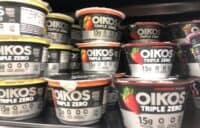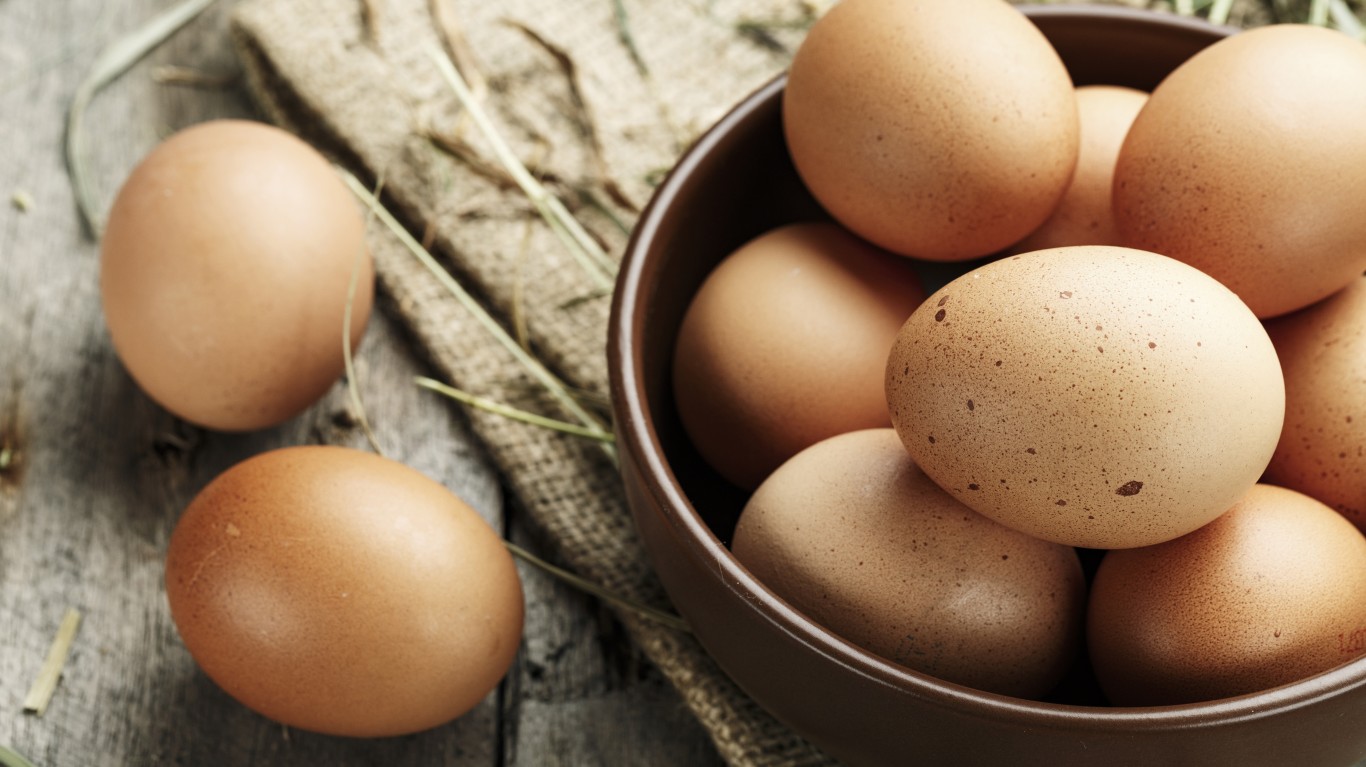
The American South covers a vast portion of the country, comprising, at least according to the U.S. Census Bureau, some 17 states and the District of Columbia — a region extending from the northeastern edge of Delaware (a scant 14 miles from Philadelphia) to Key West, Florida, and all the way west to El Paso, Texas.
Within that region — from which most people, especially in the so-called Deep South, would likely edit out Delaware, Maryland, D.C., Oklahoma, and maybe Texas — there is immense variety in climate, culture, and of course taste. But there are certain dishes enjoyed in common across many of the Southern states, however they might be defined — iconic dishes that are essential to culinary identity of the South (even if some of them didn’t actually originate there). As for the entire United States, these are the most iconic foods every state has given the rest of the U.S.
Click here for a list of iconic Southern foods everyone should try
Southern cooking is influenced by a number of traditions — Native American, English and Scottish, Spanish and French — but above all by the foodstuffs and techniques introduced to these shores or adapted here by enslaved Africans and, later, African-American servants.
The cuisine(s) of the South encompass hundreds, probably thousands, of dishes. This list, then, is highly selective, a roster of some of the most definitive foods of the region. Missing from this culinary catalogue are several discrete categories, each of which could be the subject of a lengthy list of its own: barbecue (common to all the Southern states in one form or another, with many regional variations), Texan and Tex-Mex specialties (chili con carne, fajitas, etc.), and the extremely rich and complex cooking of Louisiana’s Cajun and Creole cultures.
Among the dishes that are included, some will already be familiar to most Americans (corn bread, fried chicken), while others may be less so (chess pie, Hoppin’ John). All are very much worth trying, though — preferably on their native ground.
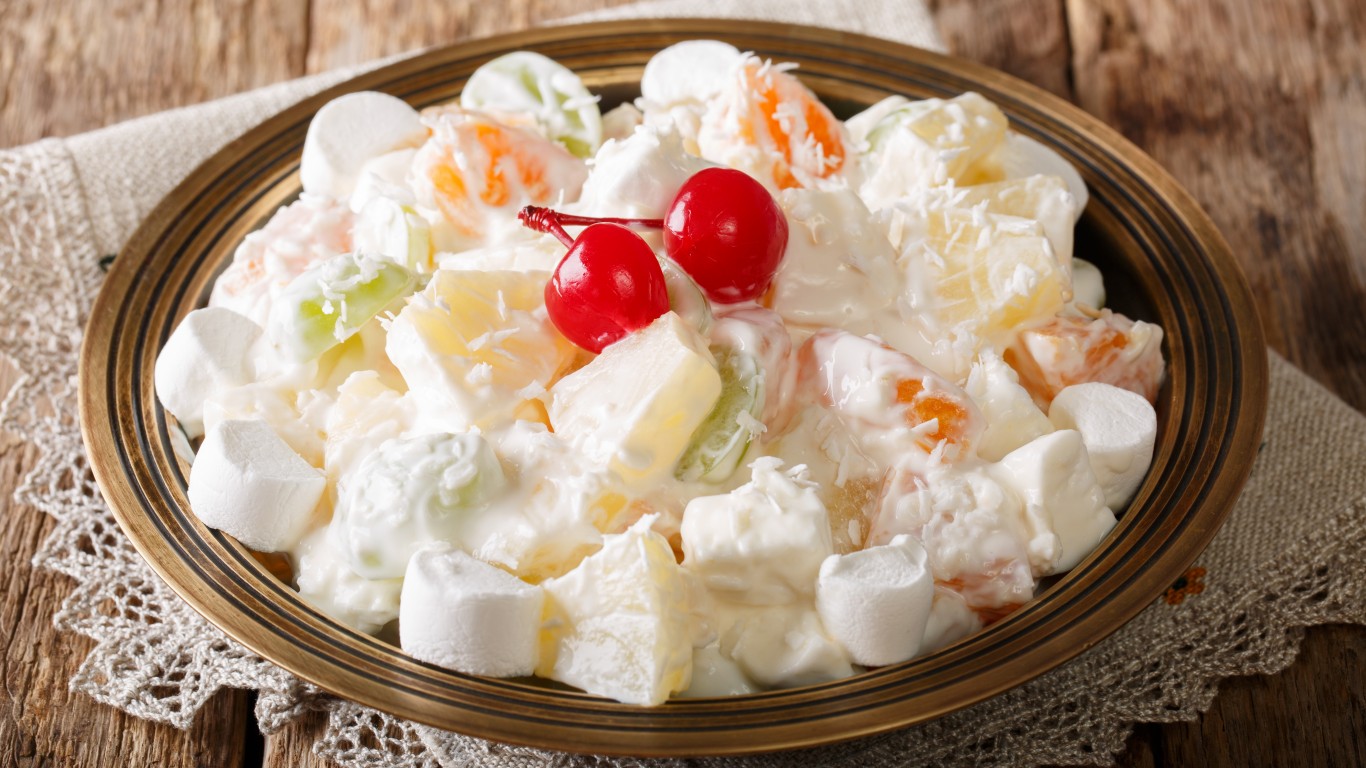
Ambrosia
In classical literature, ambrosia is the food — or drink — of the gods (the word derives from the Greek “ambrotos,” immortal). On the Southern table, ambrosia is fruit salad. Early versions, from the late 1800s, were often nothing more than orange slices with coconut and sugar. Over the years, it evolved into a more complex mixture, with varying ingredients including pineapple, maraschino cherries, marshmallows, raisins, and bananas, often with a topping of whipped cream. The one essential ingredient, everyone seems to agree, is the coconut.
[in-text-ad]

Banana pudding
Another dessert from the late 19th century, banana pudding was probably a variation on English trifle, made with sliced bananas, custard, and layers of lady fingers or sponge cake. In the 1920s, after Nabisco vanilla wafers (later renamed Nilla wafers) appeared on the market, they largely took the place of other baked goods. Today’s versions of this pudding are typically made with vanilla pudding, bananas, and Nilla wafers, and may have a meringue topping.
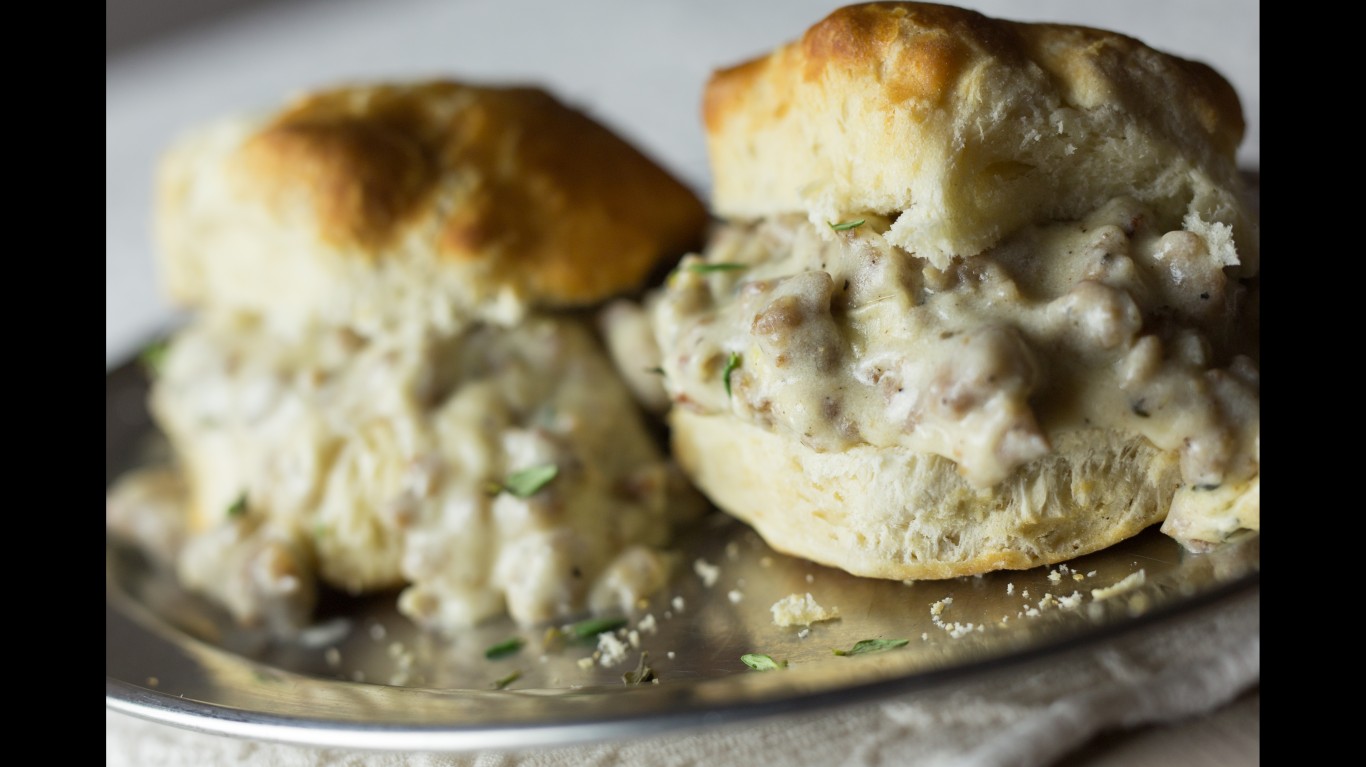
Biscuits and gravy
The gravy in question in the Southern breakfast classic, is basically a well-seasoned béchamel sauce full of crumbled pork breakfast sausage poured over split biscuits. The dish probably evolved as early as the Colonial era, with the gravy used to soften what would have then been firm hardtack-like biscuits. Today, the biscuits are light and flaky (see below).

Brunswick stew
This hearty stew was originally made with wild game, like rabbit, squirrel, sometimes even bear. It was invented either in 1898 in Brunswick, Georgia, or in 1828 in Brunswick County, Virginia (the two places still argue). Today the versions from both states and elsewhere in the South use tamer meats — chicken, pork (often smoked), sometimes beef. Onions, tomatoes, and lima beans or butter beans are other typical ingredients, while some versions include peas or potatoes. Burgoo is a Kentucky variation, made with chicken and mutton.
[in-text-ad-2]
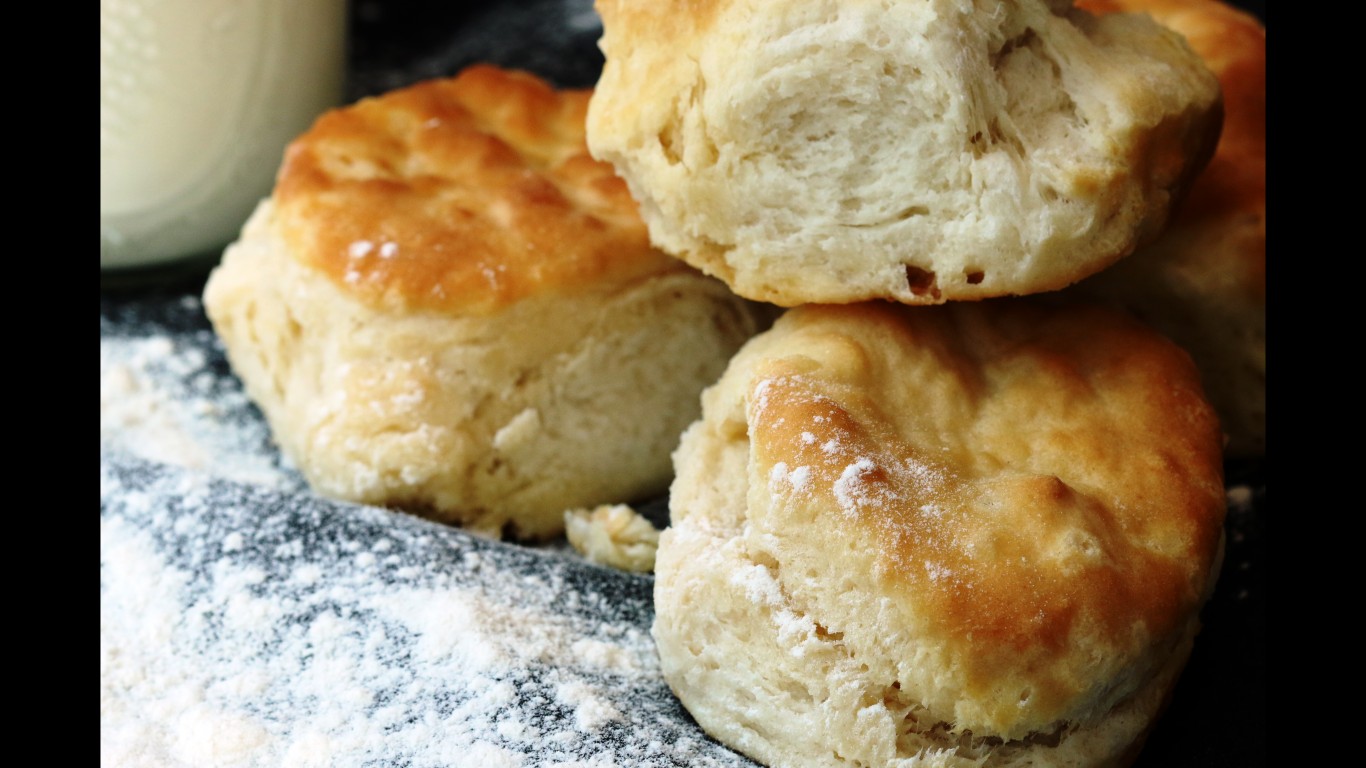
Buttermilk biscuits
Whether served slathered in butter (with or without preserves) or as the basis for biscuits and gravy (see above), light, fluffy, already buttery buttermilk biscuits are one of the South’s great culinary treats. They became popular in the late 19th century, after the White Lily company, originally based in Tennessee, started selling soft, low-protein winter-wheat biscuit flour, perfect for the recipe.
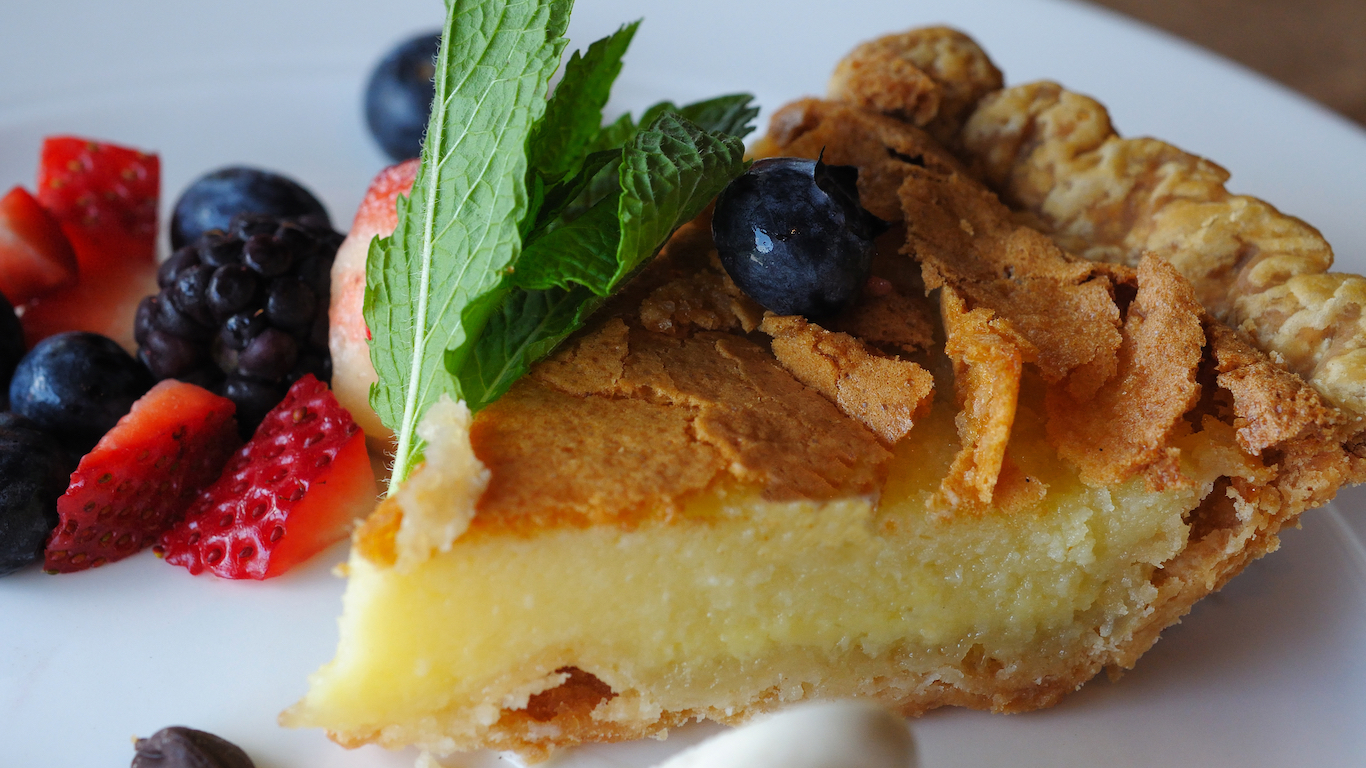
Chess pie
This custardy refrigerator pie, which dates back to the mid-18th century, has nothing to do with the game of chess. Its name might be a corruption of the term “cheese pie,” an old name for English lemon curd pie. (Another etymology suggests that when someone asked a plantation cook what kind of pie it was, she replied “jes’ pie,” and the answer was misheard.) In its simplest form, it’s made with nothing but flour, butter, sugar, and eggs.
[in-text-ad]
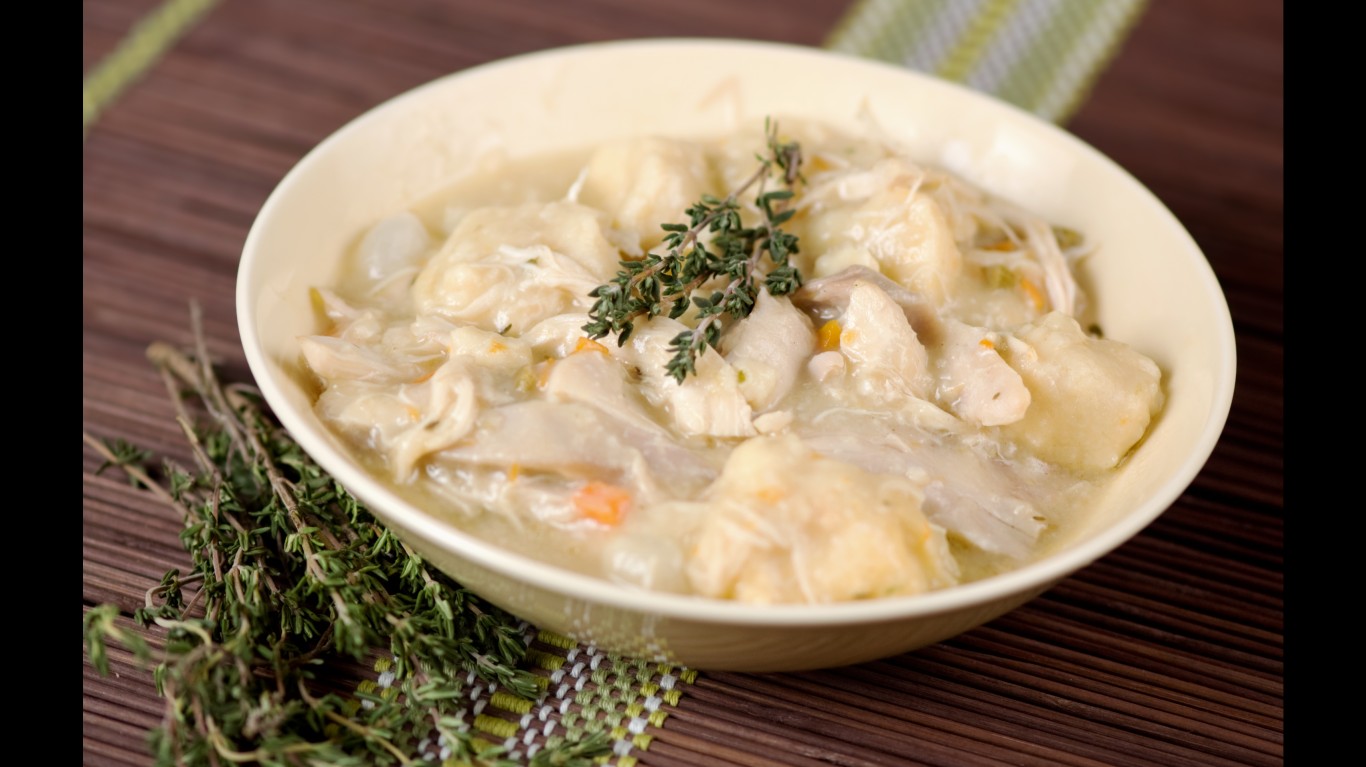
Chicken and dumplings
The story often told about this homey dish of shredded or cut-up chicken in a rich chicken broth with a few vegetables and plenty of biscuit-dough dumplings, is that it was born as an inexpensive stomach-filler during the Civil War, or possibly the Great Depression. In fact, a recipe for the dish appeared in Virginia as early as the 1830s. Ronni Lundy, author of “Victuals: An Appalachian Journey with Recipes,” described chicken and dumplings to Taste.com as “a great equalizer food,” enjoyed by Southerners from all walks of life.
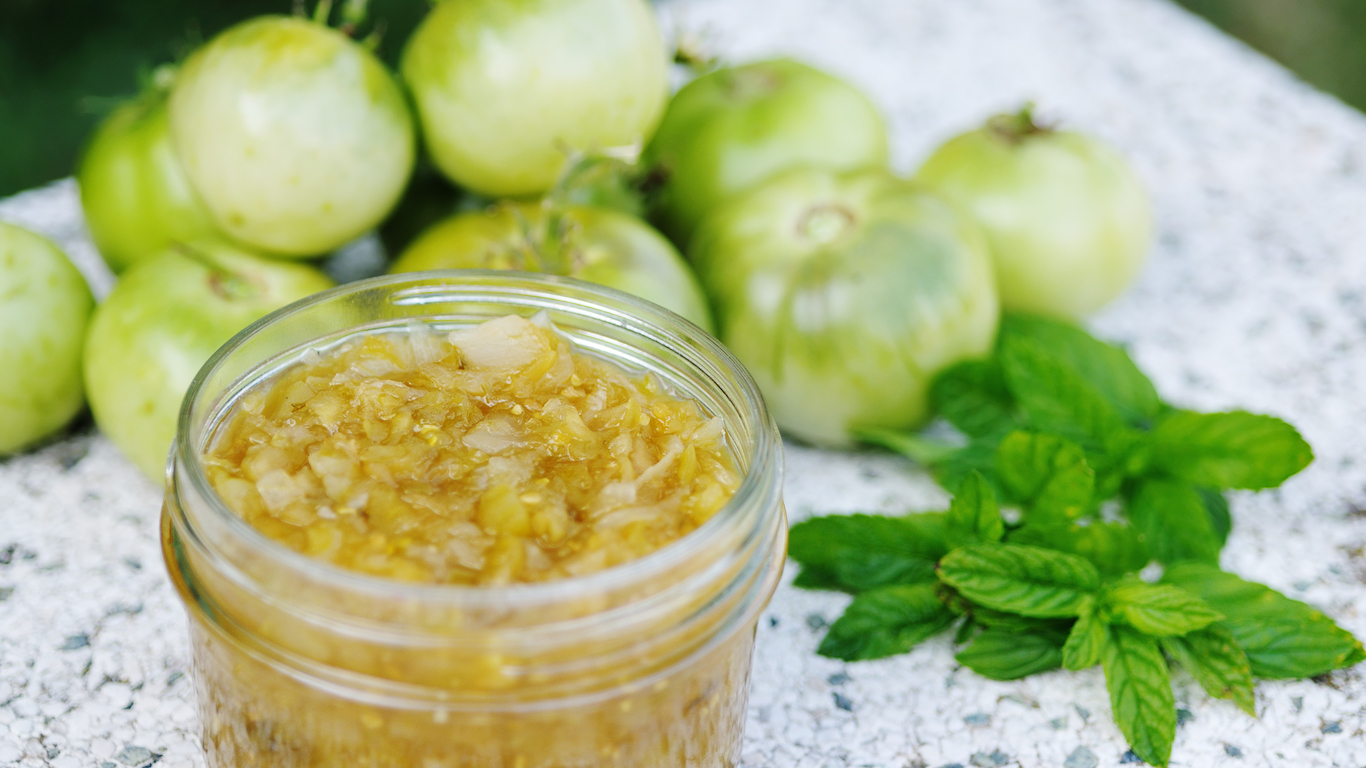
Chow chow
Chow chow is basically a pickled vegetable relish, probably originally made with autumn vegetables, like green tomatoes, cabbage, and maybe cauliflower and/or bell peppers, with vinegar, salt, and such spices as celery and/or mustard seed. A Northern version of the condiment tends to include more vegetables. A relish called piccalilli, eaten in both the northeastern U.S. and the U.K., is closely related.
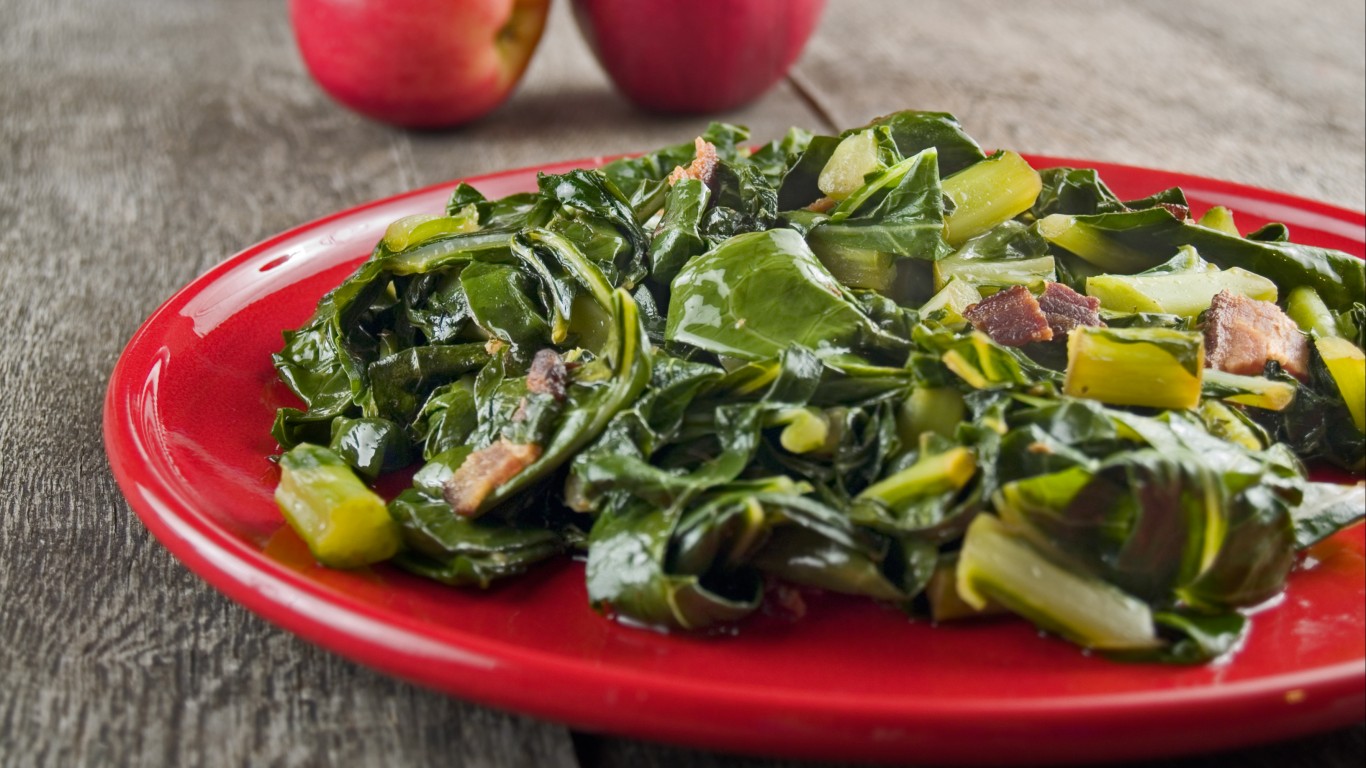
Collard greens
Collard greens are one of the oldest brassicas, the genus that includes kale, cabbage, Brussels sprouts, and broccoli. Bitter and earthy, and extremely nutritious, collards are of eastern Mediterranean origin, but the technique of boiling them in water and serving them along with the reduced cooking juices — called “pot likker” — is of African origin. The dish became a staple of so-called soul food, and is widely enjoyed across the South today.
[in-text-ad-2]

Corn bread
Cornbread, preferably made in a cast-iron skillet, is one of the staples of Southern cooking. In addition to cornmeal and salt, the recipe may include buttermilk, bacon drippings or lard, baking soda, and sometimes butter and/or white flour. Whether or not it should contain sugar is a matter of some disagreement, and it turns out that the distinction falls more or less along racial lines: black Southerners sweeten theirs, white Southerners mostly don’t. (The theory is that white cooks traditionally made theirs with more expensive sweet white cornmeal, while poorer black cooks used the cheaper yellow kind, which was less sweet and thus needed sugar.) Both kinds are delicious, and de rigueur for soaking up the aforementioned collard green pot likker.
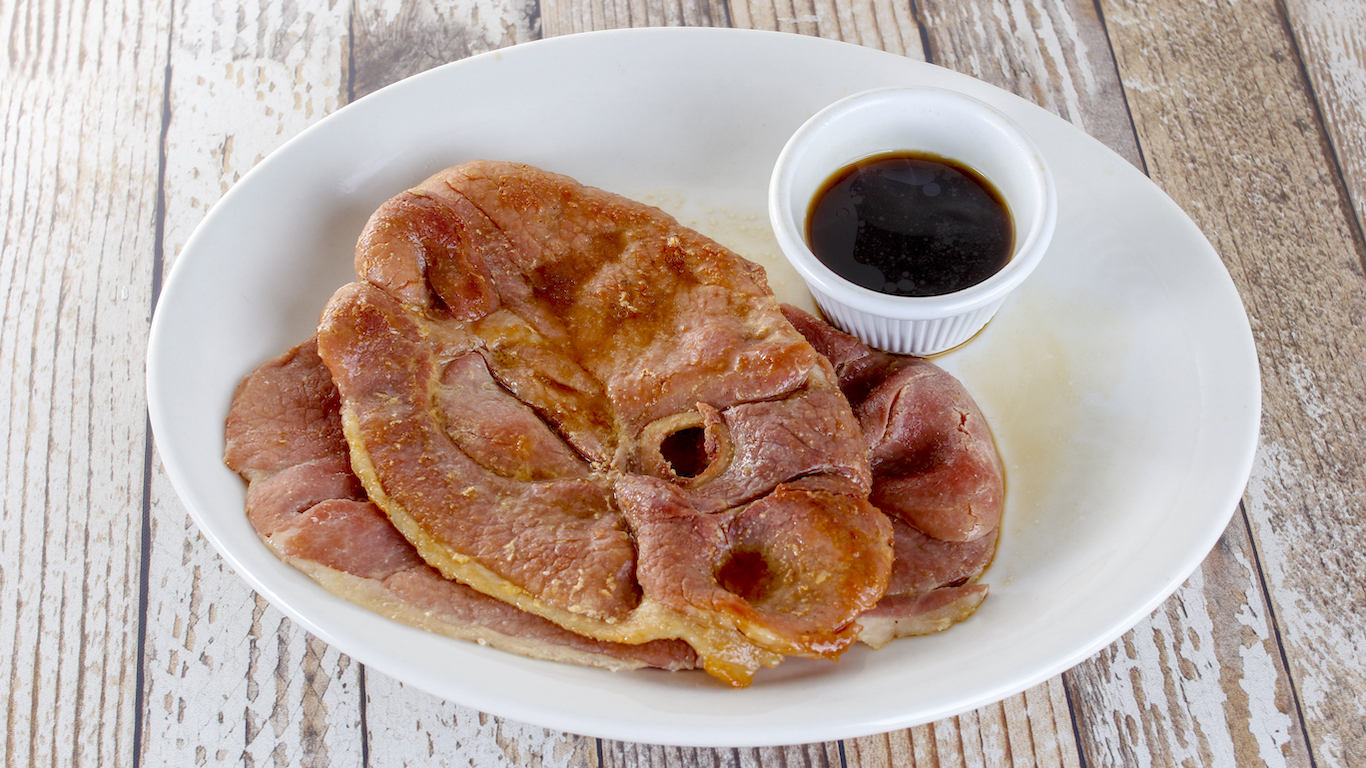
Country ham with red-eye gravy
Country ham, cured and smoked, very salty and dry, is one of the culinary treasures of the South. The classic preparation is to pan-fry thin slices of it in bacon fat, lard, or butter, then deglaze the pan with strong black coffee. The resulting gravy is said to be called “red-eye” because the layer of grease on the top is said to resemble the surface of a human eyeball. The ham is typically served for breakfast, with grits (see “shrimp and grits,” below) and fried eggs on the side and the gravy poured over both ham and grits.
[in-text-ad]

Deviled eggs
This preparation of hard-boiled eggs, with the yolk removed, mixed with mayonnaise and various seasonings (including mustard), and stuffed back into the halved whites, may be ubiquitous, but in no other region is it as much of a culinary icon as in the South. Deviled eggs were made for every occasion, every holiday, every funeral; there are even special deviled-egg plates, passed on as family heirlooms.

Fried chicken
Today, we’ve got Korean fried chicken, Japanese fried chicken, fast-food fried chicken, famous-chef fried chicken (cf. Thomas Keller, who owns some of the very best restaurants in America), and more, but Southern fried chicken still rules the roost. The idea of frying pieces of the bird was probably brought to America by Scottish immigrants to Virginia and the Carolinas in the late 18th century. (They had fried chicken in fat at home, while the English preferred to roast or bake it.) It was African slaves cooking in plantation kitchens, though, who are thought to have introduced the crispy, seasoned fried chicken we know and love today. There are countless recipes for the dish, but most now involve an egg batter enhanced with (at the minimum) salt, pepper, and paprika.

Fried green tomatoes
Don’t tell Southerners, but the earliest American recipes for this popular preparation of late-season produce appeared in Jewish cookbooks and Midwestern recipe collections from the in the late 19th and early 20th centuries. The association of the dish with Southern cooking is apparently a modern phenomenon, the result of actress and author Fannie Flagg’s 1987 novel “Fried Green Tomatoes at the Whistle Stop Cafe” and the ensuing 1991 movie “Fried Green Tomatoes.” The tomatoes were served as a side dish at the Irondale Cafe near Birmingham, Alabama, on which Flagg’s Whistle Stop was based. After the novel, and especially the film, demand for them skyrocketed, and other places began serving them too. Their origins aside, they are now a beloved part of the Southern culinary canon.
[in-text-ad-2]
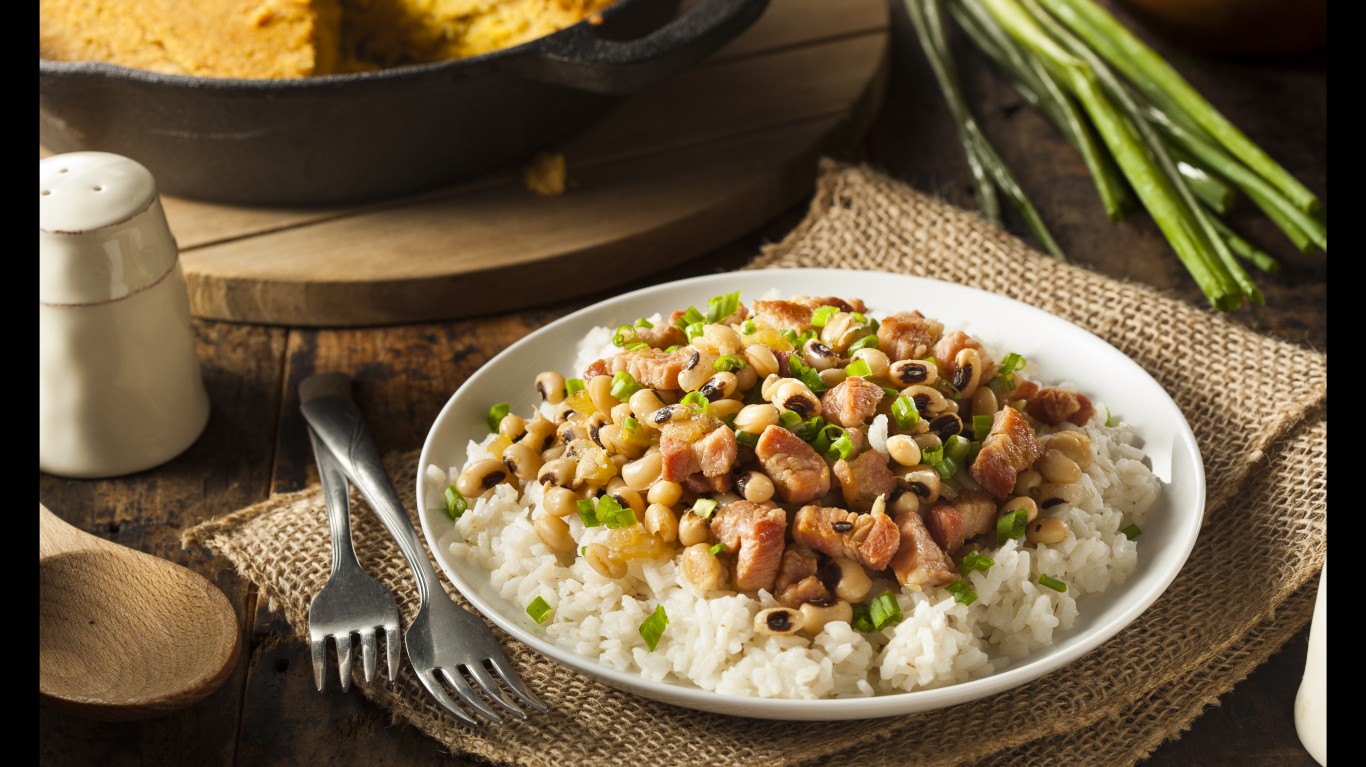
Hoppin’ John
Originating in the South Carolina Lowcountry, this mixture of rice, black-eyed peas, and pork — bacon, ham hock, or salt pork — is of obvious African inspiration (the Senegalese dish called thiebou niebe, made with rice and cow peas, is similar.) Although enjoyed all year, it is a traditional New Year’s Day dish in the South, traditionally eaten with collard greens and cornbread for the occasion. The meal is said to promise prosperity for the coming year (the greens represent dollar bills, the peas supposedly a symbol for coins).
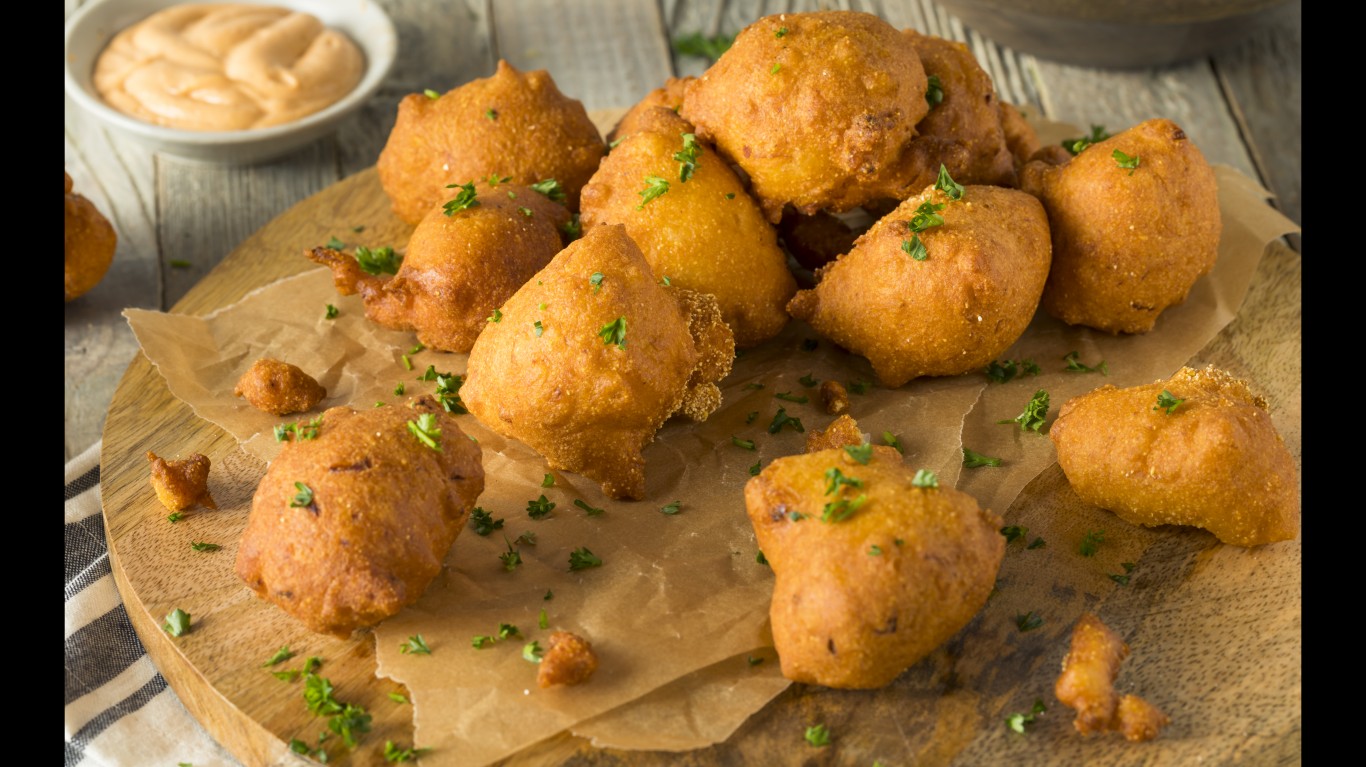
Hush puppies
Hush puppies (sometimes styled “hushpuppies”) are basically cornmeal fritters — balls or “fingers” of deep-fried sticks of egg-enriched cornmeal batter. Though they now appear on restaurant menus as an appetizer (with dipping sauce), they are traditionally a standard side dish at fried-fish dinners. Folk etymology ascribes their name to the fact that people used to toss them to restive dogs to silence them, but Southern food authority Robert Moss has convincingly debunked that story, suggesting that it might just have meant that they will stop “the dogs in your stomach from growling.”
[in-text-ad]
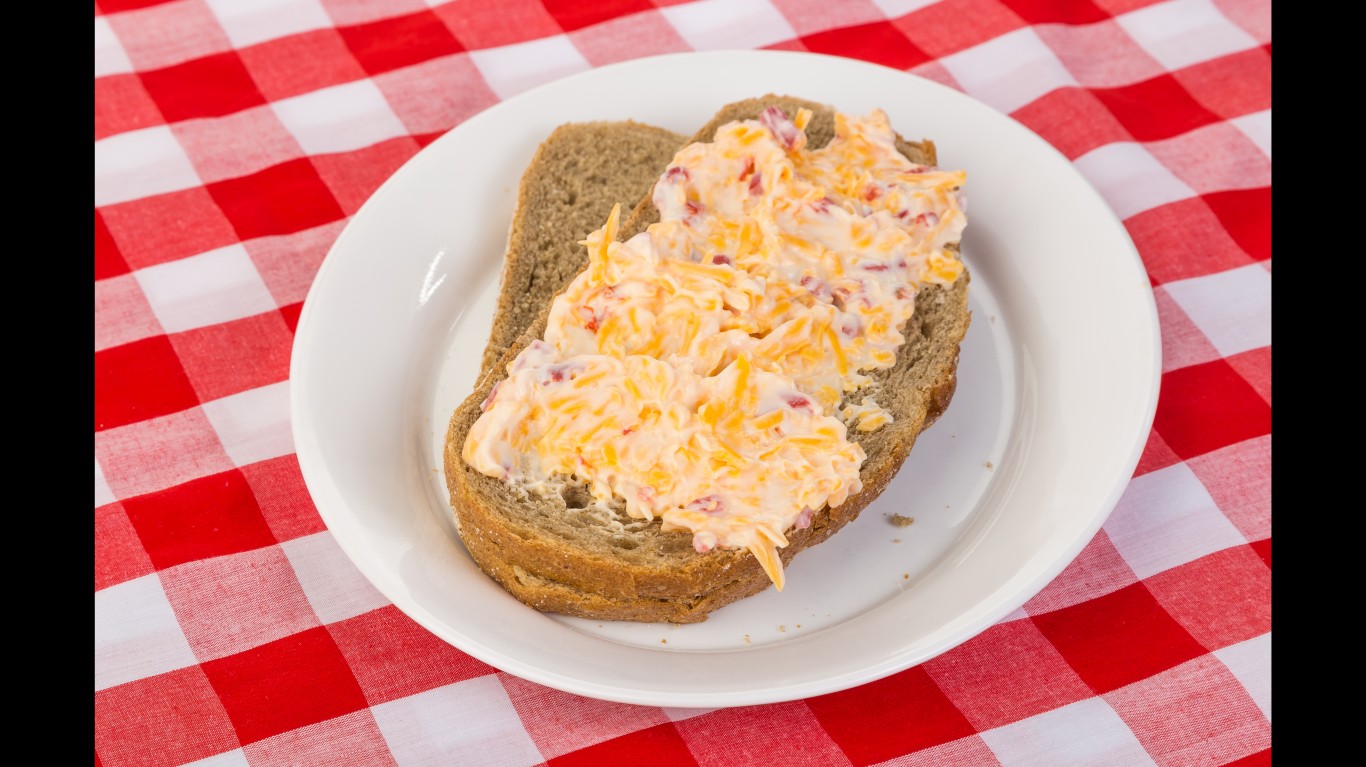
Pimento cheese
The so-called “pâté of the South,” pimento cheese is a spread or condiment made from cheese (usually either cheddar or a processed cheese like Velveeta), mayonnaise, and pimentos, sometimes with cream cheese, hot sauce, jalapeños, onions or scallions, and/or various spices added. Pimento cheese was actually invented in the North, and was commercially produced and sold across the country as early as 1910. It didn’t become identified as primarily Southern until after World War II. Today, though, pimento cheese is a staple of Southern cocktail parties, church picnics, and potlucks — and pimento cheese sandwiches are one of the traditional foods associated with the annual Augusta Masters golf tournament in Georgia.

Smothered pork chops
In the South, “smothered” foods (the technique is also applied to chicken) are fried in bacon grease or some other fat, then covered with a pan gravy made from the drippings deglazed with stock or water and thickened with flour. (Onions are often added.) Smothered pork chops are a basic dish of the African-American kitchen — they were a signature item at Paschal’s restaurant in Atlanta, a meeting place for some of the most important civil rights leaders in the ’50s and ’60s — and are considered a Southern comfort food classic.

Shrimp and grits
Grits are coarse-ground corn kernels cooked into a kind of porridge in milk or water, an adaptation of a Native American preparation. They’re common at Southern breakfasts, usually graced with butter and salt (and sometimes with grated cheese or maple syrup). On the coasts of South Carolina and Georgia, however, the Gullah — descendents of West African slaves — were known for eating grits with shrimp and other seafood. The dish remained a South Carolina specialty until 1982, when the late chef Bill Neal of the acclaimed Crook’s Corner in Chapel Hill, North Carolina, added cheese-infused grits with shrimp to his menu, attracting national attention. By the 1990s, shrimp and grits were found on menus all over the South and beyond.
[in-text-ad-2]
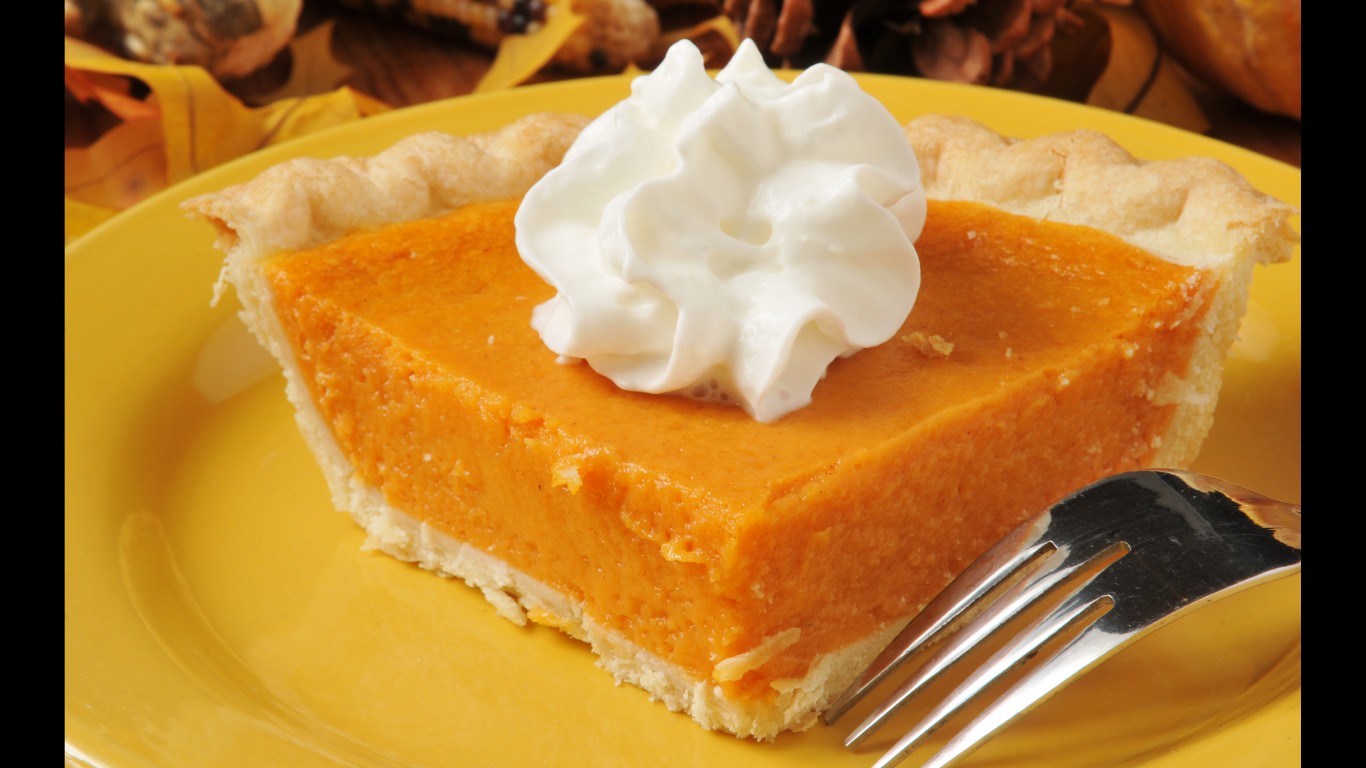
Sweet potato pie
It is thought that British colonists brought the idea of pumpkin pie (along with pumpkins, originally from the New World) to West Africa in the 16th century, and that slaves brought it to the American South — adapting it to yams, which they would have known at home, or sweet potatoes. White Southerners were no fans of pumpkin pie — it was considered a symbol of Yankee culture — so the sweet-potato version caught on across the region. The pie is usually spiced similarly to pumpkin pie and tastes a lot like it, but the filling tends to be lighter.
Cash Back Credit Cards Have Never Been This Good
Credit card companies are at war, handing out free rewards and benefits to win the best customers. A good cash back card can be worth thousands of dollars a year in free money, not to mention other perks like travel, insurance, and access to fancy lounges. See our top picks for the best credit cards today. You won’t want to miss some of these offers.
Flywheel Publishing has partnered with CardRatings for our coverage of credit card products. Flywheel Publishing and CardRatings may receive a commission from card issuers.
Thank you for reading! Have some feedback for us?
Contact the 24/7 Wall St. editorial team.
 24/7 Wall St.
24/7 Wall St.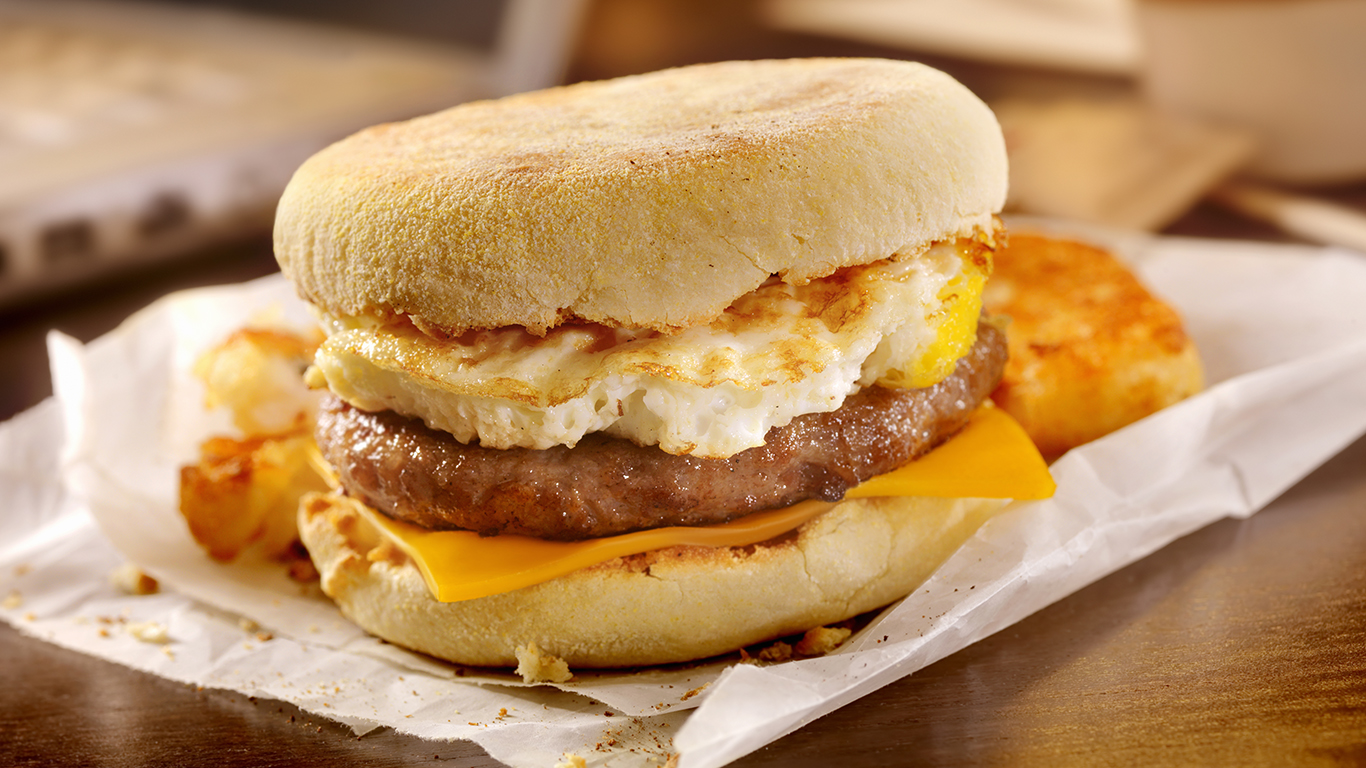 24/7 Wall St.
24/7 Wall St. 24/7 Wall St.
24/7 Wall St.